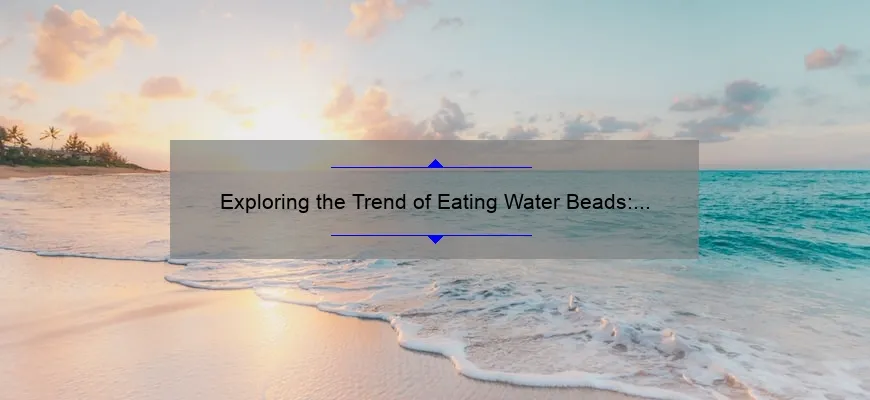Short answer eating water beads: Eating water beads can be extremely dangerous and potentially deadly as they are not meant to be ingested. Water beads, also known as gel beads or polymer beads, can expand in the stomach causing blockages or even rupture of the intestines. They should only be used for their intended purpose of decoration or sensory play with careful adult supervision.
Step-by-Step Guide to Safely Eating Water Beads
Water beads are fascinating little objects that have become increasingly popular in recent years. These tiny, squishy balls start off as small, hard beads but expand and transform once water is added to them. They make for great sensory play or decoration pieces, but many people wonder if they’re safe to eat.
The answer is yes – with some precautions taken into consideration. Here is a step-by-step guide on how to safely eat water beads:
Step 1: Choose the Right Type of Water Beads
Not all water beads are created equal; some are made specifically for decorative purposes and contain chemicals that make them unsafe for consumption. If you plan on eating water beads, it’s important to choose a food-grade variety designed for this purpose.
Step 2: Clean Your Hands Thoroughly
Before handling any food product or item intended for ingestion, like water beads, proper hand washing can go a long way in reducing the risk of illness from harmful bacteria or contamination. Clean your hands thoroughly before proceeding with each subsequent step.
Step 3: Add Water Gradually
Most manufacturers recommend adding one cup of distilled water per every teaspoon of dry boba material (water bead powder). Add the amount specified by the manufacturer gradually while stirring until you reach the desired texture – it should be slightly soft yet still plump when fully expanded.
Step 4: Allow Time For Expansion
Once you’ve added the right amount of liquid to your chosen quantity of dry boba materials (food grade), allow time for them to fully expand – which usually takes several hours
Step 5: Rinse With Running Water
Once your hydration has occurred completely rinse under running tap cold water at least thrice .
While there’s no denying that consuming these fun little spheres can pose potential risks like choking hazards if not handled carefully. It’s also equally essential always take cautionand use good judgement when ingesting anything new regardless its safety level so a small amount first to ensure that there are no adverse effects is recommended. If you encounter any problems or feel unwell, consult with your healthcare provider immediately and seek professional medical help.
Eating water beads can be completely safe if done the right way; the key here lies in proper preparation and usage. With these simple steps taken into consideration, you’ll be able to enjoy this fun and unusual snack without worry.
Eating Water Beads FAQ: Answers to Common Questions
Water beads, also known as jelly balls or crystal soil, have become quite popular in recent years due to their unique properties. These tiny, polymer-based beads can absorb and hold a significant amount of water — up to 100 times their own weight! But what are they exactly? And is it safe to eat them? In this blog post, we’ll delve into some frequently asked questions about eating water beads and provide you with all the answers you need.
Q: What are water beads?
A: Water beads are small, gel-like balls that expand when exposed to water. They’re commonly used for home decor purposes, such as filling vases or creating sensory play activities for kids.
Q: Can you eat water beads?
A: While it’s not recommended to eat water beads, they are non-toxic and will not cause harm if ingested in small amounts. However, consuming large quantities could lead to choking hazards or digestive issues.
Q: Why would someone want to eat water beads?
A: People might be curious about the texture or taste of these colorful pearls. Some individuals may even use them as part of a diet plan since they provide a feeling of fullness without adding any calories.
Q: Are there any nutritional benefits from eating water beads?
A: No. Water beads offer no nutritional value whatsoever — besides hydration from the absorbed liquid
Q: How should I prepare/serve them if I absolutely must try eating them?
A:Treat your curiosities by thoroughly washing multiple sets with cool running tap-water until the gems (about 2-3) become clear before placing onto tongue- don’t chew
Q:Is There an FDA-approved way Kinde capsule technology uses hydrogel polymers similar but does that make it safer ?
While there may be other products out on the market that utilize hydrogel polymers similarly like within Kind capsuled medications/candies – It’s important not to mix any potentially edible substances with water beads as that is not the intended use of these items and can be risky.
Q: Can kids eat water beads?
A: We do not recommend children consume Water Beads under any circumstances whatsoever. Small parts can easily become a hazard if ingested
Q: Are there any risks associated with eating water beads?
A: There are several risks involved in consuming water beads. These include choking hazards, digestive blockages, dehydration due to loss of bodily fluids from prolonged ingestion.
In conclusion, while it may seem like an interesting or fun thing to try out by eating them for some people- DO NOT EAT WATER BEADS! They hold no nutritional value and offer potential danger far outweighs their entertainment value ( if any). If you have additional questions about water beads or want more information before giving into temptations surfing the web – seek professional advice from eligible professionals such as doctors/nutritionists/health advisors rather than relying on hearsay suggestions online because your diet matters much more than those few moments taste-testing gems in your mouth .





